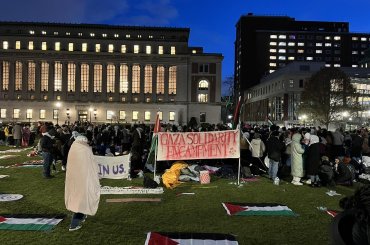Entry 8 in the Mondo Awards end-of-year contest.
Year before last, I was sitting in the living room of my childhood home sharing a cup of morning coffee with my mother and musing over the holidays. We laughed over kitschy Christmas gifts from well-meaning relatives before deciding to turn on the news for five minutes on the brink of another vacation day. Those five minutes would turn out to be one of those times like 9/11—when you never forget exactly where you were when you found out. “Oh no,” gasped my mother, tears welling up immediately in her eyes. “Gaza Explodes…” scrolled across the bottom of the screen, and plumes of smoke hung on the living room wall in high definition.
Violence in the Middle East was hardly a surprise. I was living near the West Bank city of Ramallah in 2006, where I began to understand the intricacies of life under occupation—checkpoints, settlement expansion, and raids. That summer, Hamas and Hezbollah abducted three Israeli soldiers, and the Israeli military unleashed a series of attacks that devastated parts of Gaza and Lebanon. I remember sitting on my roof with neighbors sipping local Palestinian beer from a nearby Christian village, and watching macabre lights fill the sky night after night. A former European soldier taught me how to identify the various weapons: a cluster bomb branches out horizontally before hitting its target, while thermobarics fall hard and fast, demolishing entire structures. The warplanes were low, lit up by the moon as they traveled north to Lebanon and south to Gaza. My neighbor finished the last sip of his beer one night and whispered, “It’s like fucking Space Invaders up here.”
But operation Cast Lead put previous attacks to shame. For more than three weeks, the Israeli military assault was the most violent action against the occupied territories since the 1967 war. And for the past two years, I have been breathing in Gaza from the outside, sustained by a few precious journeys into the coastal territory known by many as the world’s largest open-air prison.
During the war, I spent hours on the phone with people inside Gaza—from the comfort of my eclectic office and heated apartment. Colleagues and friends filled me in from their cell phones while they stood on dangerous street corners watching bombs flatten buildings. We would almost always lose our connection and when I called back, they would apologize for the interruption and describe the scene in detail. One day, a Palestinian man working for the United Nations cried helplessly when white phosphorus danced through the sky like firecrackers. Or like Space Invaders.
Israel stopped attacking the Gaza Strip two days before the U.S. presidential inauguration. Many speculate that the Israeli withdrawal was a trade-off with the President-elect for his silence during the military operation. I stood shoulder to shoulder with hundreds of thousands of people in front of my country’s capitol building on what felt then like the first day of a new millennium, Obama’s charismatic voice crackling through the freezing air as he took the oath. Hope had taken the nation by storm, Bush was on a helicopter bound for Texas, and the streets of Gaza were silent. Razed, I would soon witness just weeks later, but silent.
Getting into Gaza right after the war was nothing short of a miracle. I entered with a delegation through Rafah on the Egyptian side. We passed by Palestinians who had no chance of crossing the gate, and I knew that it was they who should have been granted passage, not me. Bombs fell on the tunnels near the buffer zone, but somehow, being in Gaza made me feel incredibly safe. And the resilience of the people crept to a place deep inside me. It hasn’t left since.
The Gaza Strip is full of astonishing stories and the people there go to lengths to get them out. Being a visitor in that context is a privilege that comes with considerable responsibility. From speaking with families who lost loved ones to tank fire to spending time with children that trembled from the affects of PTSD, there was consistent desire to be heard. “Now you have seen this with your own eyes,” they would say, “so you need to let people outside know what is happening to us here.”
The second I left, I immediately started planning another trip. And then another. Within a year of the war, I had been back three times. Gaza is the kind of place that melts stereotypes. Let down by the Israelis, the Egyptians, the Americans, and the Palestinian Authority, Gazans continue to organize despite oppressive circumstances. They have burned garbage to fuel cars, built homes from mud, and crushed rubble to pave roads. Women from local community organizations bank seeds in their kitchen sinks and plant gardens in the most unlikely urban settings.
Today, the siege on Gaza continues with no end in sight. The United Nations has reported that at least 500 truckloads of wheat sit idle on the Israeli side of the Karni conveyor belt that has acted as a lifeline to a million and a half people. Even though these provisions are critical to survival, Palestinians living in the seaside enclave long for much more than access to food aid, but for freedom of movement, food sovereignty, and self- determination.
And now, military violence against Gaza has escalated again. One contact wrote that F16s had bombed several times over the past week, drones buzzing overhead as he sent out the message. Some Palestinians feel that another wide-reaching attack looms. It remains unclear exactly what awaits the people of Gaza two years after the war. What is certain is that we must keep their voices in the debate, and listen when they say enough is enough—especially when so many of us are intrinsically linked to their struggle.
Salena Tramel is the program coordinator for the Middle East and Haiti at Grassroots International.

